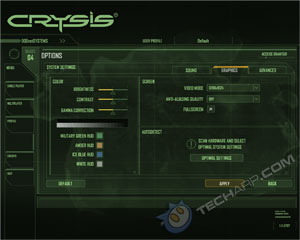Crysis Benchmarking Guide
At this moment, Crysis is the toughest test you can subject any graphics card to. It requires so much graphics processing power that it humbles even new graphics cards like the GeForce 8800 GT and the GeForce 8800 GTS 512MB graphics card. As such, it serves as a great benchmark for graphics cards (as well as CPUs).
Benchmarking your graphics card using Crysis is very easy. Crytek has conveniently created two batch files that allows you to easily run repeated time demos to obtain an average frame rate. Let's take a look at the process.
Setting Up
The first thing you should do before benchmarking Crysis is ensure that you have Crysis fully patched to the latest version. At print time, that's Version 1.1. You can get the Crysis 1.1 patch here.
The version 1.1 patch improves performance in Crysis by roughly 5%. So, if you upgrade to Crysis 1.1, you cannot compare its results with that from Crysis 1.0 or the Crysis demo. For more details on Crysis 1.1 and its performance improvements, take a look at this article.
You should also ensure you are using the latest driver for your graphics card. If you are testing multiple CPUs, do not change your graphics card or its driver when you swap to a different CPU. Changing either the graphics card or its driver will skew your results and render them useless for accurate comparisons.
If you are using an NVIDIA graphics card, you can download the latest driver here - http://www.nvidia.com/page/drivers.html. If you are using an ATI-AMD graphics card, you can download the latest driver here - http://ati.amd.com/support/driver.html.
Change The Display Settings
Before we start benchmarking, the first thing we need to do is change the display settings in Crysis. To do that, load Crysis and go to Options -> System Settings. First, start with the Graphics tab. Here, you can set the resolution and anti-aliasing quality. You can also set the game to run in full-screen or windowed mode.
For the most strenuous workout for your card, select the highest resolution your monitor supports. It is not advisable to select anti-aliasing, except for testing purposes. After selecting the resolution and anti-aliasing mode you want, click Apply.
 |
Then, click on the Advanced tab. Here, you can change the rendering quality in Crysis. Generally, we would just change all the settings simultaneously to High or Very High. It is recommended that you select the setting of High. After selecting the rendering quality you want, click Apply.
That's it. Now that you have set the resolution, anti-aliasing and rendering quality you want to test, you can proceed to benchmark your graphics card.







 Add to Reddit
Add to Reddit

